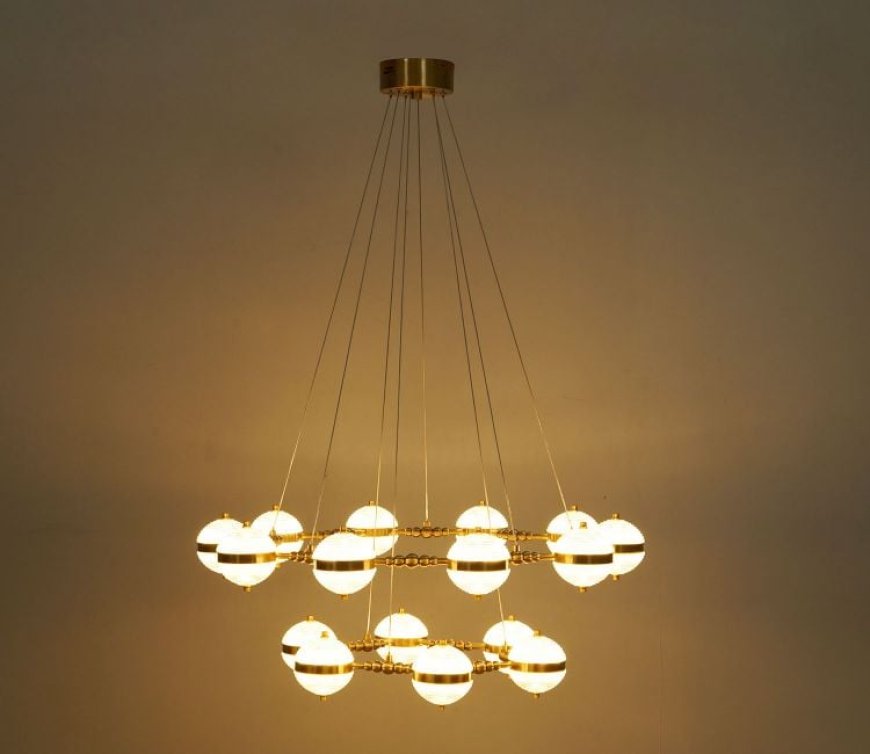The History and Evolution of Chandeliers: From Palaces to Modern Homes

Chandeliers have long been a symbol of elegance, sophistication, and artistic craftsmanship. They have adorned the ceilings of opulent palaces, grand ballrooms, and stately homes for centuries, evolving through time to suit the changing tastes and functional needs of homeowners. Today, chandeliers continue to shine brightly in contemporary interiors, particularly as a sought-after chandelier for living room decor, where they create a focal point and elevate the ambiance. Understanding the fascinating journey of chandeliers offers insight into why they remain such a timeless choice in lighting design.
Origins of Chandeliers: The Birth of an Icon
The word “chandelier” originates from the French word chandelle, meaning candleholder. Early chandeliers were simple wooden crosses fitted with spikes to hold candles. These functional pieces emerged in medieval times, primarily used in churches and the homes of the wealthy. They provided much-needed illumination in an era before electric lights and were often suspended by chains from the ceiling to cast light evenly throughout large rooms.
As craftsmanship improved during the Renaissance period, chandeliers became more elaborate. Metalwork artisans began crafting ornate frames from bronze and iron, incorporating intricate scrolls and decorative elements. These early designs were both practical and a display of status. Owning an elaborate chandelier symbolized wealth and sophistication, and it was during this time that they became a defining feature in the grand halls of European nobility.
The Crystal Revolution: The Age of Opulence
By the 17th century, the evolution of glassmaking techniques led to the introduction of crystal chandeliers. The addition of cut glass and lead crystals not only enhanced the visual appeal of chandeliers but also improved their light-diffusing capabilities. As candlelight passed through the prisms, it created dazzling displays of refracted light, filling spaces with a warm, inviting glow.
Crystal chandeliers became the centerpiece of royal courts and grand estates across Europe. In places such as Versailles, chandeliers were designed with hundreds of shimmering crystals, reflecting the extravagance of their surroundings. This period cemented the chandelier’s reputation as the pinnacle of elegance and refined taste, a status symbol that many aspired to possess.
The Advent of Electricity: A New Era of Lighting
The 19th century brought about a revolutionary change with the invention of electric lighting. Chandeliers were among the first lighting fixtures to embrace this new technology. Designers adapted traditional forms to incorporate electric bulbs, which offered greater safety and convenience compared to open-flame candles.
With the introduction of electricity, chandeliers became more accessible to a wider audience. No longer confined to the wealthy elite, they found their way into middle-class homes, public buildings, and even commercial spaces. The designs also began to diversify, incorporating various artistic movements such as Art Nouveau and Art Deco, which infused chandeliers with modernist sensibilities while retaining their timeless charm.
Contemporary Chandeliers: Blending Tradition with Innovation
Today, chandeliers continue to evolve, blending the grandeur of the past with the functionality and style demands of modern living. A chandelier for living room remains one of the most popular lighting choices, prized for its ability to transform an ordinary space into an extraordinary one. Whether hanging in a minimalist loft, a contemporary apartment, or a cozy family home, chandeliers offer unmatched versatility.
Contemporary designers experiment with a variety of materials — from metals and wood to glass and fabric — crafting chandeliers that suit a wide range of interior styles. The introduction of LED technology has also expanded creative possibilities, allowing for more energy-efficient and dynamic lighting options. Modern chandeliers can be sculptural works of art, minimalist fixtures, or grand, crystal-studded centerpieces, all while providing functional illumination.
The Enduring Appeal of Chandeliers
The reason chandeliers remain so beloved lies in their unique ability to marry function with artistry. They do more than provide light; they create atmosphere, draw the eye upward, and add a sense of drama to any space. In a chandelier for living room, this impact is particularly profound. The living room is often the heart of the home, a space where families gather, entertain guests, and relax. A well-chosen chandelier can set the tone for the entire room, making it feel warm, inviting, and stylish.
Moreover, chandeliers speak to a sense of tradition and continuity. They connect us to centuries of craftsmanship and design history while still allowing for individual expression through modern forms. This blend of past and present ensures that chandeliers will continue to hold a treasured place in home decor for generations to come.
Conclusion
From their humble beginnings as simple wooden candleholders to their modern incarnations as dazzling focal points, chandeliers have undergone a remarkable transformation. Yet throughout history, they have consistently represented elegance, creativity, and human ingenuity. In today’s homes, especially when selecting a chandelier for living room, this timeless lighting fixture continues to inspire and enchant, proving that some designs never go out of style. Whether in a palace or a modern apartment, the chandelier remains an enduring symbol of beauty and light.


































































![https //g.co/recover for help [1-866-719-1006]](https://newsquo.com/uploads/images/202506/image_430x256_684949454da3e.jpg)
























![How Smart PMs Scale Their Careers in Any Org [TPG Live Recap]](https://tpgblog.com/wp-content/uploads/2025/06/2025-06-12-thumbnail-action.png?#)


















































